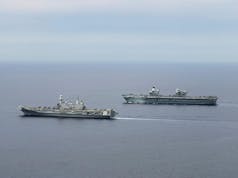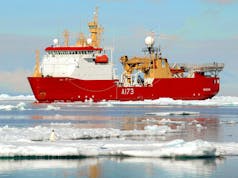British Frigate HMS Kent and Destroyer HMS Defender have conducted a combined shore bombardment off the Scottish coast as part of Exercise Joint Warrior.
And it’s not just underwater warfare we excel at. We conducted a combined shore bombardment with @hmsdefender pic.twitter.com/eOt09XUFJT
— HMS Kent (@hms_kent) October 9, 2020
The training in Scotland is part of Joint Warrior exercise. Joint Warrior incorporates surface, subsurface, airborne, and land assets providing joint training in a multi-threat environment for NATO units. Exercise Joint Warrior is the largest military exercise in Europe, bringing together the Royal Navy, the Royal Air Force and the British Army, as well as forces from other nations.
“Joint Warrior is our premier venue for recertifying our ships for fleet operations, and the synergy with the Royal Navy could not be better,” said U.S. Navy Capt. Joseph Gagliano, Commander, Task Force (CTF) 65. “We count on them to keep our ships ready, and they can always count on our commitment to security in this theatre.”
British forces join 6,000 personnel from Belgium, Canada, Denmark, Estonia, France, Germany, Latvia, Lithuania, the Netherlands, Norway, Portugal and the US for this iteration, which is scheduled to include 28 ships, two submarines and 81 aircraft.
What’s the purpose of the exercise?
The Ministry of Defence say that the aim is to provide a complex environment in which the participants can train together, honing tactics and skills in preparation for deployment as a Combined Joint Task Force.
“The scenario for each Joint Warrior is designed to reflect contemporary political tensions – such as the War on Terror and the threat posed by ISIS – and to simulate the hostilities that might result from them. The ultimate aim? To assure maximum preparedness in the face of any threat.”
This massive multinational war exercise involves warships, aircraft, marines and troops from UK, NATO and allied forces. The exercise doesn’t only allow participating units to hone their specialist roles within a larger war-style setting – it also helps foster vital links between the UK, NATO and other allied militaries.













Still seems madness to equip our most “expendable” new frigates(31s) with just a 57mm, leaving our most expensive & valuable T45s & 26s to do this. I don’t believe NGS nor ship to ship gunfire is past. Better to standardise the 5″ across the escort fleet; failing that, 76mm should be the minimum but I’d rather se 4.5 or 5″.
I agree
Yep, T31s should have a 5″ mount with 57mm mounts fore and aft. A pair of 30mm mounts amidships on both sides to round it off. Great for dealing with swarming boats and splattering larger vessel if needs be!
Madness to pay the price for 5″ gun, better to redesign 4.5″. make it fully automatic and scale down all 5″ ammo to work.with the same. In the scheme of things the development costs are unlikely to exceed 100m GBP. if export cutomers want the 5″ that’s OK.
Its doable and then we have a home grown product. Otherwise I can see us never making another home grown artillery piece of any description. Like tanks, etc ,etc.
If BAE own the copyright on the 5″ then they can do a deal to scale down the ammo. Just a question of resetting the lathes to run off a batch..
I take it that the comment is tongue in cheek…if not you had a typo of a 1 that should be a 7
Except for a completely different type of ammo, 5″ is separate shell and propellant as opposed to the all one piece 4.5″, a different feed system, magazine stowage system, deck strengthening and safety case…yes its exactly the same and shouldn’t cost anymore than 700m to sort out…